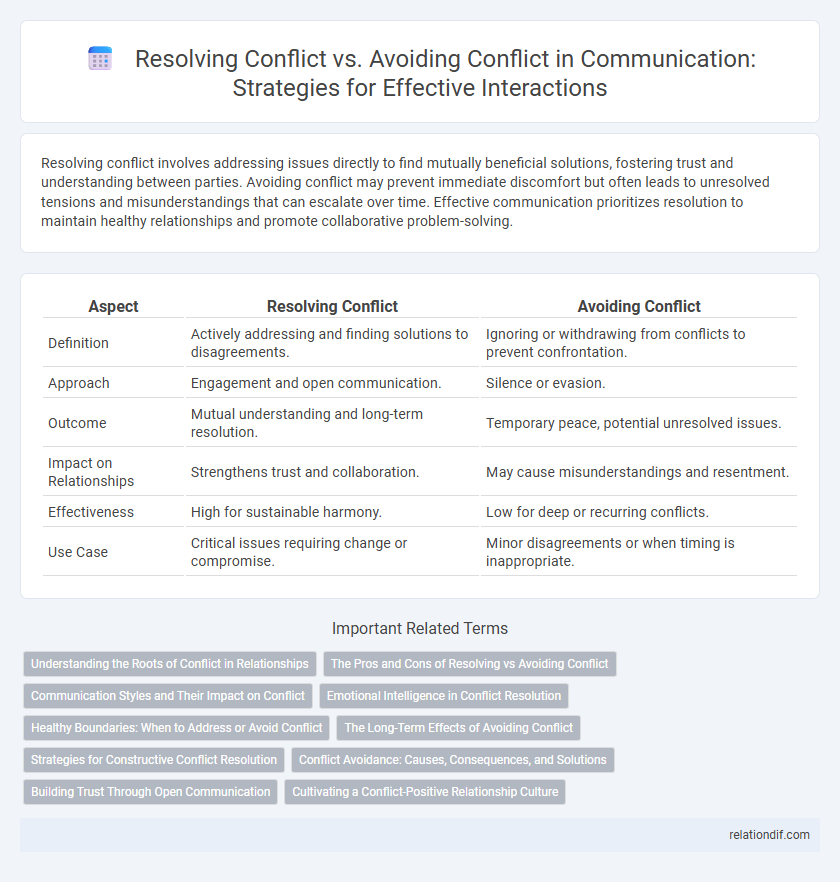Resolving conflict involves addressing issues directly to find mutually beneficial solutions, fostering trust and understanding between parties. Avoiding conflict may prevent immediate discomfort but often leads to unresolved tensions and misunderstandings that can escalate over time. Effective communication prioritizes resolution to maintain healthy relationships and promote collaborative problem-solving.
Table of Comparison
| Aspect | Resolving Conflict | Avoiding Conflict |
|---|---|---|
| Definition | Actively addressing and finding solutions to disagreements. | Ignoring or withdrawing from conflicts to prevent confrontation. |
| Approach | Engagement and open communication. | Silence or evasion. |
| Outcome | Mutual understanding and long-term resolution. | Temporary peace, potential unresolved issues. |
| Impact on Relationships | Strengthens trust and collaboration. | May cause misunderstandings and resentment. |
| Effectiveness | High for sustainable harmony. | Low for deep or recurring conflicts. |
| Use Case | Critical issues requiring change or compromise. | Minor disagreements or when timing is inappropriate. |
Understanding the Roots of Conflict in Relationships
Understanding the roots of conflict in relationships involves identifying underlying emotions, unmet needs, and contrasting values that drive disagreements. Resolving conflict requires addressing these core issues through open, honest dialogue and empathetic listening to foster mutual understanding. Avoiding conflict often leads to unresolved tensions and miscommunication, which can erode trust and intimacy over time.
The Pros and Cons of Resolving vs Avoiding Conflict
Resolving conflict promotes open communication, fosters mutual understanding, and often leads to long-term relationship improvement, but it can be time-consuming and emotionally challenging. Avoiding conflict can prevent immediate tension and maintain superficial harmony, yet it risks unresolved issues escalating and damages trust over time. Effective communication strategies balance the benefits of direct resolution with the potential drawbacks of avoidance to maintain healthy interpersonal dynamics.
Communication Styles and Their Impact on Conflict
Direct communication styles promote open dialogue and transparency, which often lead to effective conflict resolution by addressing issues head-on. Indirect communication styles can contribute to avoiding conflict, but may result in misunderstandings and unresolved tensions. Understanding and adapting to different communication styles enhances conflict management and fosters healthier interpersonal relationships.
Emotional Intelligence in Conflict Resolution
Emotional intelligence plays a crucial role in resolving conflict by enabling individuals to recognize, understand, and manage their emotions and those of others, fostering empathy and effective communication. Avoiding conflict often stems from emotional discomfort or fear of negative outcomes, which can lead to unresolved issues and increased tension. Developing emotional intelligence enhances conflict resolution skills by promoting self-awareness, emotional regulation, and constructive dialogue, ultimately leading to healthier interpersonal relationships.
Healthy Boundaries: When to Address or Avoid Conflict
Healthy boundaries require recognizing when to address conflict directly to foster open communication and mutual understanding, preventing resentment and breakdowns in relationships. Avoiding conflict can be appropriate when emotions are too high or the issue is minor, allowing time for reflection and cooling down. Balancing these approaches promotes emotional well-being and maintains respect within personal and professional interactions.
The Long-Term Effects of Avoiding Conflict
Avoiding conflict often leads to unresolved issues that fester and escalate over time, damaging trust and communication within relationships. Persistent avoidance can result in increased stress, resentment, and a breakdown of collaboration in both personal and professional settings. Long-term conflict avoidance undermines emotional well-being and productivity by preventing healthy dialogue and problem-solving.
Strategies for Constructive Conflict Resolution
Effective conflict resolution strategies include active listening, which ensures all parties feel heard and understood, and collaborative problem-solving that focuses on finding mutually beneficial solutions. Encouraging open dialogue and maintaining emotional control help de-escalate tensions, fostering a constructive environment for addressing disagreements. Implementing clear communication protocols and seeking mediation when necessary can transform conflicts into opportunities for growth and improved relationships.
Conflict Avoidance: Causes, Consequences, and Solutions
Conflict avoidance often stems from fear of confrontation, desire to maintain harmony, or lack of communication skills, leading to unresolved issues that escalate tension and reduce trust. Consequences include increased stress, damaged relationships, and poor decision-making as important problems remain unaddressed. Effective solutions involve fostering open communication, encouraging emotional intelligence, and implementing conflict resolution training to empower individuals to address conflicts constructively.
Building Trust Through Open Communication
Resolving conflict fosters trust by encouraging transparent dialogue and mutual understanding, whereas avoiding conflict often leads to unresolved issues that undermine trust. Open communication creates a safe space for expressing concerns, promoting empathy and collaboration between parties. Consistently addressing conflicts directly strengthens relationships and builds long-term trust in personal and professional settings.
Cultivating a Conflict-Positive Relationship Culture
Cultivating a conflict-positive relationship culture encourages open dialogue and fosters trust, enabling teams to address issues constructively rather than avoiding them. Resolving conflict through active listening and empathy promotes collaboration, innovation, and stronger interpersonal bonds. Avoiding conflict often leads to unresolved tensions, decreased morale, and hindered organizational growth.
Resolving conflict vs Avoiding conflict Infographic

 relationdif.com
relationdif.com